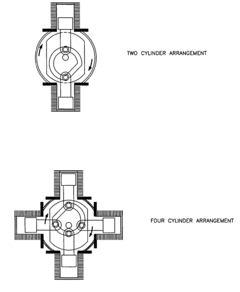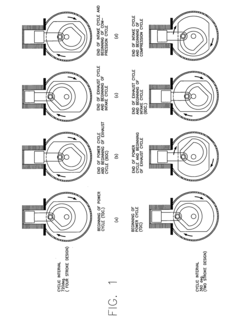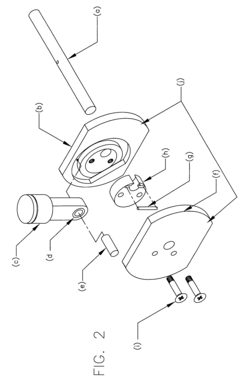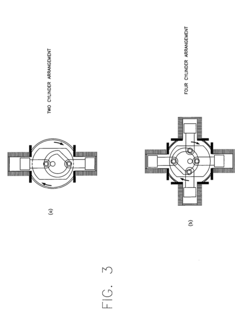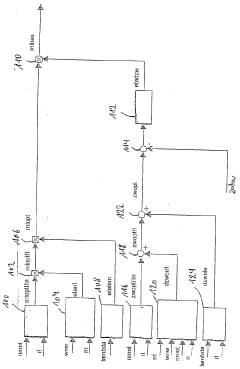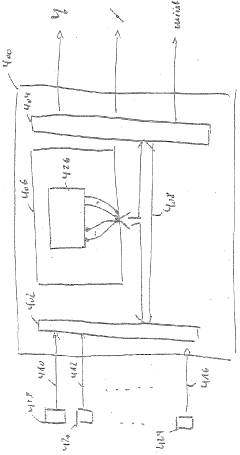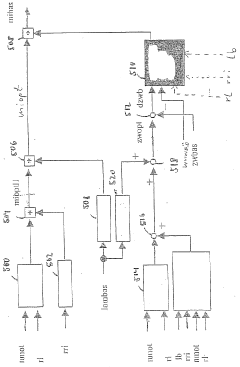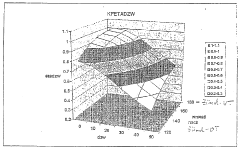V8 Engine Torque Curve: Optimization Techniques Gone Over
JUL 4, 20259 MIN READ
Generate Your Research Report Instantly with AI Agent
Patsnap Eureka helps you evaluate technical feasibility & market potential.
V8 Engine Torque Evolution
The evolution of V8 engine torque curves has been a journey of continuous refinement and innovation. In the early days of V8 engines, torque curves were often characterized by a narrow power band, with peak torque occurring at relatively high RPMs. This resulted in engines that were powerful but less efficient and responsive across the full range of operating conditions.
As automotive technology progressed, engineers focused on broadening the torque curve to improve drivability and fuel efficiency. The introduction of variable valve timing (VVT) in the 1980s marked a significant milestone in this evolution. VVT allowed for optimized valve operation across different engine speeds, resulting in improved low-end torque without sacrificing high-end power.
The 1990s saw the widespread adoption of electronic fuel injection systems, which provided more precise control over fuel delivery. This technology enabled engineers to fine-tune the air-fuel mixture at different engine speeds, further enhancing the torque curve's shape and consistency. Concurrently, advancements in engine management systems allowed for more sophisticated control strategies, optimizing combustion efficiency across a wider range of operating conditions.
The turn of the millennium brought about a renewed focus on forced induction, particularly turbocharging. Modern turbocharged V8 engines exhibit remarkably flat torque curves, with peak torque available from very low RPMs and sustained across a broad range. This characteristic, often referred to as "plateau torque," has significantly improved the real-world performance and efficiency of V8 engines.
Recent years have seen the integration of direct fuel injection technology, which has further refined torque delivery. By precisely controlling fuel injection timing and pressure, engineers have achieved even more efficient combustion, resulting in improved low-end torque and overall engine responsiveness. Additionally, the implementation of cylinder deactivation systems has allowed V8 engines to operate more efficiently under light load conditions while maintaining their ability to deliver full power when needed.
Looking ahead, the evolution of V8 engine torque curves is likely to be influenced by the increasing electrification of powertrains. Hybrid systems that combine V8 engines with electric motors have the potential to fill in torque gaps and provide instantaneous low-end torque, further smoothing out the overall torque curve. As emissions regulations become more stringent, these hybrid V8 powertrains may become more prevalent, offering a balance between traditional V8 performance and improved efficiency.
As automotive technology progressed, engineers focused on broadening the torque curve to improve drivability and fuel efficiency. The introduction of variable valve timing (VVT) in the 1980s marked a significant milestone in this evolution. VVT allowed for optimized valve operation across different engine speeds, resulting in improved low-end torque without sacrificing high-end power.
The 1990s saw the widespread adoption of electronic fuel injection systems, which provided more precise control over fuel delivery. This technology enabled engineers to fine-tune the air-fuel mixture at different engine speeds, further enhancing the torque curve's shape and consistency. Concurrently, advancements in engine management systems allowed for more sophisticated control strategies, optimizing combustion efficiency across a wider range of operating conditions.
The turn of the millennium brought about a renewed focus on forced induction, particularly turbocharging. Modern turbocharged V8 engines exhibit remarkably flat torque curves, with peak torque available from very low RPMs and sustained across a broad range. This characteristic, often referred to as "plateau torque," has significantly improved the real-world performance and efficiency of V8 engines.
Recent years have seen the integration of direct fuel injection technology, which has further refined torque delivery. By precisely controlling fuel injection timing and pressure, engineers have achieved even more efficient combustion, resulting in improved low-end torque and overall engine responsiveness. Additionally, the implementation of cylinder deactivation systems has allowed V8 engines to operate more efficiently under light load conditions while maintaining their ability to deliver full power when needed.
Looking ahead, the evolution of V8 engine torque curves is likely to be influenced by the increasing electrification of powertrains. Hybrid systems that combine V8 engines with electric motors have the potential to fill in torque gaps and provide instantaneous low-end torque, further smoothing out the overall torque curve. As emissions regulations become more stringent, these hybrid V8 powertrains may become more prevalent, offering a balance between traditional V8 performance and improved efficiency.
Market Demand Analysis
The market demand for V8 engine torque curve optimization techniques has been steadily growing in recent years, driven by several key factors. Automotive manufacturers are under increasing pressure to improve fuel efficiency and reduce emissions while maintaining or enhancing vehicle performance. This has led to a surge in demand for advanced engine optimization technologies, particularly for high-performance V8 engines.
In the luxury and sports car segments, where V8 engines are prevalent, there is a strong consumer appetite for vehicles that offer both power and efficiency. This market trend has pushed manufacturers to invest heavily in torque curve optimization techniques. The demand is further amplified by the racing industry, where even marginal improvements in engine performance can translate to significant competitive advantages.
The commercial vehicle sector, especially in heavy-duty trucks and construction equipment, also contributes significantly to the market demand. These industries require engines that can deliver high torque across a wide range of operating conditions, making torque curve optimization a critical factor in product development.
Environmental regulations and fuel economy standards have become increasingly stringent worldwide. This regulatory landscape has created a substantial market for technologies that can help manufacturers meet these standards without compromising on performance. As a result, the demand for sophisticated engine management systems and optimization techniques has seen a marked increase.
The aftermarket tuning industry represents another significant segment driving demand for torque curve optimization techniques. Performance enthusiasts and tuning shops are constantly seeking ways to extract more power and efficiency from V8 engines, creating a robust market for optimization tools and services.
Emerging markets, particularly in Asia and South America, are showing increased interest in high-performance vehicles, further expanding the global demand for V8 engine optimization technologies. As these markets mature, the demand for more refined and efficient engines is expected to grow substantially.
The integration of digital technologies and advanced analytics in engine development has opened new avenues for torque curve optimization. This has led to a growing demand for software solutions and data-driven optimization tools, creating opportunities for tech companies to enter the automotive engineering space.
As the automotive industry moves towards electrification, there is a parallel trend of maximizing the efficiency and performance of traditional combustion engines. This has resulted in a 'last hurrah' effect, where manufacturers are investing heavily in optimizing V8 engines to showcase the pinnacle of internal combustion technology before a potential shift to electric powertrains.
In the luxury and sports car segments, where V8 engines are prevalent, there is a strong consumer appetite for vehicles that offer both power and efficiency. This market trend has pushed manufacturers to invest heavily in torque curve optimization techniques. The demand is further amplified by the racing industry, where even marginal improvements in engine performance can translate to significant competitive advantages.
The commercial vehicle sector, especially in heavy-duty trucks and construction equipment, also contributes significantly to the market demand. These industries require engines that can deliver high torque across a wide range of operating conditions, making torque curve optimization a critical factor in product development.
Environmental regulations and fuel economy standards have become increasingly stringent worldwide. This regulatory landscape has created a substantial market for technologies that can help manufacturers meet these standards without compromising on performance. As a result, the demand for sophisticated engine management systems and optimization techniques has seen a marked increase.
The aftermarket tuning industry represents another significant segment driving demand for torque curve optimization techniques. Performance enthusiasts and tuning shops are constantly seeking ways to extract more power and efficiency from V8 engines, creating a robust market for optimization tools and services.
Emerging markets, particularly in Asia and South America, are showing increased interest in high-performance vehicles, further expanding the global demand for V8 engine optimization technologies. As these markets mature, the demand for more refined and efficient engines is expected to grow substantially.
The integration of digital technologies and advanced analytics in engine development has opened new avenues for torque curve optimization. This has led to a growing demand for software solutions and data-driven optimization tools, creating opportunities for tech companies to enter the automotive engineering space.
As the automotive industry moves towards electrification, there is a parallel trend of maximizing the efficiency and performance of traditional combustion engines. This has resulted in a 'last hurrah' effect, where manufacturers are investing heavily in optimizing V8 engines to showcase the pinnacle of internal combustion technology before a potential shift to electric powertrains.
Current Challenges
The optimization of V8 engine torque curves faces several significant challenges in the current technological landscape. One of the primary obstacles is the inherent trade-off between peak power output and low-end torque. Engineers must balance these competing factors to achieve optimal performance across the entire RPM range, which often requires complex compromises in engine design and tuning.
Another major challenge lies in meeting increasingly stringent emissions regulations while maintaining or improving engine performance. The need to reduce harmful emissions, particularly NOx and particulate matter, often conflicts with strategies that enhance torque output. This necessitates the development of advanced combustion technologies and aftertreatment systems, which can add complexity and cost to the engine design.
Fuel efficiency remains a critical concern in V8 engine optimization. As global energy demands shift towards more sustainable solutions, engineers must find ways to extract maximum torque from each unit of fuel consumed. This challenge is compounded by the fact that traditional methods of increasing torque, such as increasing displacement or boost pressure, often come at the expense of fuel economy.
The integration of new materials and manufacturing techniques presents both opportunities and challenges in torque curve optimization. While lightweight materials can improve power-to-weight ratios, they may also introduce durability concerns or increased production costs. Advanced manufacturing methods, such as 3D printing of complex components, offer new design possibilities but require significant investment in research and development.
Thermal management is another crucial challenge in V8 engine optimization. As engineers push for higher specific outputs, managing heat becomes increasingly difficult. Excessive heat can lead to reduced efficiency, increased wear, and potential reliability issues. Developing effective cooling systems that do not compromise aerodynamics or add significant weight is a complex engineering task.
The pursuit of a flat torque curve, which provides consistent power delivery across a wide RPM range, remains a significant challenge. This often requires sophisticated valve timing systems, variable geometry turbochargers, or other advanced technologies. Implementing these systems while maintaining reliability and cost-effectiveness is a delicate balancing act.
Lastly, the increasing electrification of powertrains presents both challenges and opportunities for V8 engine torque optimization. Integrating electric motors for torque fill or hybrid assistance can dramatically alter the torque curve, but requires careful integration and control strategies to maximize the benefits of both power sources.
Another major challenge lies in meeting increasingly stringent emissions regulations while maintaining or improving engine performance. The need to reduce harmful emissions, particularly NOx and particulate matter, often conflicts with strategies that enhance torque output. This necessitates the development of advanced combustion technologies and aftertreatment systems, which can add complexity and cost to the engine design.
Fuel efficiency remains a critical concern in V8 engine optimization. As global energy demands shift towards more sustainable solutions, engineers must find ways to extract maximum torque from each unit of fuel consumed. This challenge is compounded by the fact that traditional methods of increasing torque, such as increasing displacement or boost pressure, often come at the expense of fuel economy.
The integration of new materials and manufacturing techniques presents both opportunities and challenges in torque curve optimization. While lightweight materials can improve power-to-weight ratios, they may also introduce durability concerns or increased production costs. Advanced manufacturing methods, such as 3D printing of complex components, offer new design possibilities but require significant investment in research and development.
Thermal management is another crucial challenge in V8 engine optimization. As engineers push for higher specific outputs, managing heat becomes increasingly difficult. Excessive heat can lead to reduced efficiency, increased wear, and potential reliability issues. Developing effective cooling systems that do not compromise aerodynamics or add significant weight is a complex engineering task.
The pursuit of a flat torque curve, which provides consistent power delivery across a wide RPM range, remains a significant challenge. This often requires sophisticated valve timing systems, variable geometry turbochargers, or other advanced technologies. Implementing these systems while maintaining reliability and cost-effectiveness is a delicate balancing act.
Lastly, the increasing electrification of powertrains presents both challenges and opportunities for V8 engine torque optimization. Integrating electric motors for torque fill or hybrid assistance can dramatically alter the torque curve, but requires careful integration and control strategies to maximize the benefits of both power sources.
Existing Optimization Methods
01 Torque curve optimization for V8 engines
Various methods are employed to optimize the torque curve of V8 engines, including adjusting valve timing, modifying fuel injection parameters, and fine-tuning engine control systems. These techniques aim to improve engine performance across different RPM ranges, resulting in a more balanced and efficient power delivery.- Torque curve optimization for V8 engines: Various methods are employed to optimize the torque curve of V8 engines, including adjusting valve timing, modifying fuel injection parameters, and fine-tuning engine control units. These techniques aim to improve engine performance across different RPM ranges, resulting in a more balanced and efficient power delivery.
- Variable valve timing for torque enhancement: Implementing variable valve timing systems in V8 engines allows for dynamic adjustment of valve opening and closing times. This technology enables the engine to optimize torque output at different engine speeds, improving overall performance and fuel efficiency throughout the engine's operating range.
- Electronic control systems for torque management: Advanced electronic control systems are utilized to manage and optimize torque output in V8 engines. These systems monitor various engine parameters and adjust fuel injection, ignition timing, and other factors in real-time to maintain optimal torque curves under different driving conditions.
- Turbocharging and supercharging for torque enhancement: Forced induction systems, such as turbochargers and superchargers, are employed to increase the torque output of V8 engines. These systems compress the intake air, allowing for more fuel to be burned and resulting in higher torque production across a wider RPM range.
- Cylinder deactivation for improved torque characteristics: Cylinder deactivation technology is implemented in some V8 engines to improve torque characteristics and fuel efficiency. By selectively deactivating cylinders under light load conditions, the engine can operate more efficiently while maintaining the ability to deliver full power when needed.
02 Variable valve timing for torque enhancement
Implementing variable valve timing systems in V8 engines allows for dynamic adjustment of valve opening and closing times. This technology enables the engine to optimize its torque output at different speeds, improving overall performance and fuel efficiency throughout the engine's operating range.Expand Specific Solutions03 Turbocharging and supercharging for increased torque
Forced induction systems, such as turbochargers and superchargers, are utilized to enhance the torque output of V8 engines. These systems increase air intake, allowing for more fuel combustion and resulting in higher torque production, especially at lower RPMs.Expand Specific Solutions04 Electronic control systems for torque management
Advanced electronic control systems are employed to manage and optimize torque production in V8 engines. These systems use sensors and algorithms to continuously adjust engine parameters, ensuring optimal torque delivery under various driving conditions and enhancing overall engine efficiency.Expand Specific Solutions05 Cylinder deactivation for improved torque characteristics
Cylinder deactivation technology is implemented in V8 engines to selectively shut down cylinders under light load conditions. This technique helps maintain optimal torque characteristics while improving fuel efficiency, particularly during low-demand driving scenarios.Expand Specific Solutions
Key Industry Players
The V8 engine torque curve optimization landscape is characterized by intense competition among established automotive manufacturers and suppliers. The market is in a mature phase, with significant ongoing research and development efforts. Key players like Toyota, BMW, Volvo, and Bosch are investing heavily in refining V8 engine performance. The technology's maturity level is high, with incremental improvements being the focus. Companies such as GM, Porsche, and Ford are leveraging their extensive experience to push the boundaries of V8 engine efficiency and power delivery. The market size remains substantial, driven by demand in high-performance vehicles and luxury segments, although facing pressure from alternative powertrain technologies.
GM Global Technology Operations LLC
Technical Solution: GM has developed a Dynamic Skip Fire (DSF) technology for V8 engines, which selectively deactivates cylinders based on driving conditions. This system optimizes the torque curve by allowing the engine to operate in various cylinder configurations, from 2 to 8 cylinders. The DSF technology uses sophisticated algorithms to determine the optimal firing sequence and cylinder activation pattern in real-time, considering factors such as engine load, speed, and driver demand[1]. GM's implementation includes advanced vibration control measures and a specially designed camshaft to ensure smooth operation across all cylinder configurations[3].
Strengths: Improved fuel efficiency, reduced emissions, and enhanced torque management across a wide range of operating conditions. Weaknesses: Increased system complexity and potential for higher maintenance costs due to additional components.
Ford Global Technologies LLC
Technical Solution: Ford has implemented a dual-fuel injection system in their V8 engines, combining port and direct injection. This system optimizes the torque curve by precisely controlling fuel delivery based on engine speed and load. At lower RPMs, port injection is primarily used for better fuel atomization and smoother operation, while direct injection takes over at higher RPMs for improved power and efficiency. Ford's system also incorporates advanced variable valve timing and lift technologies, allowing for dynamic adjustment of valve events to optimize torque output across the entire RPM range[2]. Additionally, Ford has developed a plasma transferred wire arc (PTWA) coating for cylinder bores, reducing friction and improving heat transfer, which contributes to a more consistent torque curve[4].
Strengths: Enhanced torque delivery across a wide RPM range, improved fuel efficiency, and reduced emissions. Weaknesses: Higher production costs and increased complexity in engine management systems.
Core Torque Technologies
Torque improved engine or T.I.E
PatentInactiveUS20060102135A1
Innovation
- The Torque Increased Efficiency (T.I.E.) design modifies the mechanical geometry by incorporating an offset disc that rotates in an orbit around the output shaft axis, increasing leverage during the power stroke with a 45-degree inclination, thereby enhancing torque transmission, while maintaining efficiency during other strokes by reverting to a common radius after 90 degrees rotation.
Method and device, in addition to a computer program, for controlling an internal combustion engine
PatentWO2003062633A1
Innovation
- The method improves the torque model by incorporating the efficiency factors related to combustion characteristics and gas exchange valve opening times, allowing for precise calculation of indicated engine torque even with early exhaust valve opening, and enables the determination of optimal ignition angles and fillings through detailed characteristic maps and partial efficiencies.
Emissions Regulations Impact
The impact of emissions regulations on V8 engine torque curve optimization has been significant and far-reaching. As governments worldwide implement increasingly stringent emissions standards, automotive manufacturers have been compelled to adapt their engine designs and performance characteristics to meet these requirements. This has led to a complex interplay between achieving optimal torque curves and adhering to emissions limits.
One of the primary challenges in optimizing V8 engine torque curves under strict emissions regulations is the need to reduce fuel consumption and emissions without compromising performance. This has led to the development and implementation of various technologies, such as variable valve timing, direct fuel injection, and turbocharging. These technologies allow for more precise control over the combustion process, enabling engineers to fine-tune the torque curve while simultaneously reducing emissions.
The introduction of catalytic converters and particulate filters has also played a crucial role in emissions reduction. However, these components can create back pressure in the exhaust system, potentially affecting the engine's ability to produce optimal torque across the rev range. Engineers must carefully balance the design of exhaust systems to minimize this impact while ensuring compliance with emissions standards.
Another significant factor is the shift towards downsizing and downspeeding in engine design. This trend, driven by emissions regulations, has led to smaller displacement V8 engines that rely more heavily on forced induction to achieve desired power and torque outputs. While this approach can yield impressive results in terms of emissions reduction, it presents new challenges in maintaining the characteristic torque curve traditionally associated with naturally aspirated V8 engines.
The implementation of start-stop systems and cylinder deactivation technologies, aimed at reducing fuel consumption and emissions during idle and low-load conditions, has further complicated the task of torque curve optimization. Engineers must ensure smooth transitions between different operating modes while maintaining consistent torque delivery across various driving scenarios.
Moreover, the increasing focus on real-world driving emissions (RDE) testing has forced manufacturers to optimize engine performance across a broader range of operating conditions. This has led to the development of more sophisticated engine management systems and control strategies that can adapt to various driving situations while maintaining compliance with emissions regulations.
In conclusion, emissions regulations have fundamentally altered the landscape of V8 engine torque curve optimization. While presenting significant challenges, these regulations have also driven innovation in engine technology, resulting in more efficient and cleaner V8 engines that still deliver impressive performance characteristics.
One of the primary challenges in optimizing V8 engine torque curves under strict emissions regulations is the need to reduce fuel consumption and emissions without compromising performance. This has led to the development and implementation of various technologies, such as variable valve timing, direct fuel injection, and turbocharging. These technologies allow for more precise control over the combustion process, enabling engineers to fine-tune the torque curve while simultaneously reducing emissions.
The introduction of catalytic converters and particulate filters has also played a crucial role in emissions reduction. However, these components can create back pressure in the exhaust system, potentially affecting the engine's ability to produce optimal torque across the rev range. Engineers must carefully balance the design of exhaust systems to minimize this impact while ensuring compliance with emissions standards.
Another significant factor is the shift towards downsizing and downspeeding in engine design. This trend, driven by emissions regulations, has led to smaller displacement V8 engines that rely more heavily on forced induction to achieve desired power and torque outputs. While this approach can yield impressive results in terms of emissions reduction, it presents new challenges in maintaining the characteristic torque curve traditionally associated with naturally aspirated V8 engines.
The implementation of start-stop systems and cylinder deactivation technologies, aimed at reducing fuel consumption and emissions during idle and low-load conditions, has further complicated the task of torque curve optimization. Engineers must ensure smooth transitions between different operating modes while maintaining consistent torque delivery across various driving scenarios.
Moreover, the increasing focus on real-world driving emissions (RDE) testing has forced manufacturers to optimize engine performance across a broader range of operating conditions. This has led to the development of more sophisticated engine management systems and control strategies that can adapt to various driving situations while maintaining compliance with emissions regulations.
In conclusion, emissions regulations have fundamentally altered the landscape of V8 engine torque curve optimization. While presenting significant challenges, these regulations have also driven innovation in engine technology, resulting in more efficient and cleaner V8 engines that still deliver impressive performance characteristics.
Fuel Efficiency Strategies
Fuel efficiency strategies for V8 engines have become increasingly important in the automotive industry, driven by environmental concerns and regulatory pressures. In the context of optimizing the torque curve of V8 engines, several key approaches have emerged to enhance fuel economy without compromising performance.
One primary strategy involves variable valve timing and lift systems. These advanced systems allow for precise control over the engine's intake and exhaust valves, optimizing airflow and combustion efficiency across different engine speeds and load conditions. By adjusting valve timing and lift dynamically, engineers can fine-tune the torque curve to provide better low-end torque while maintaining high-end power, resulting in improved fuel efficiency throughout the engine's operating range.
Cylinder deactivation technology has also proven effective in reducing fuel consumption, particularly in V8 engines. This system selectively shuts down a portion of the engine's cylinders during light load conditions, effectively reducing displacement and fuel consumption without sacrificing the ability to deliver full power when needed. The seamless activation and deactivation of cylinders contribute to a smoother torque curve and enhanced fuel economy during cruising and low-demand driving scenarios.
Direct fuel injection systems have revolutionized fuel delivery in modern V8 engines. By precisely controlling the timing and amount of fuel injected directly into the combustion chamber, these systems optimize the air-fuel mixture for more complete combustion. This not only improves fuel efficiency but also allows for higher compression ratios, contributing to increased torque output across the engine's rev range.
Turbocharging and supercharging technologies have been widely adopted to improve both performance and fuel efficiency in V8 engines. These forced induction systems allow for downsizing of engine displacement while maintaining or even increasing power output. By optimizing boost pressure and integrating advanced waste gate control strategies, engineers can shape the torque curve to provide robust low-end torque and smooth power delivery, all while improving overall fuel economy.
Advanced engine management systems and electronic control units (ECUs) play a crucial role in implementing these fuel efficiency strategies. Sophisticated algorithms and real-time sensor data enable precise control over fuel injection, ignition timing, and other engine parameters. This level of control allows for adaptive optimization of the engine's performance and efficiency based on driving conditions, further refining the torque curve and maximizing fuel economy.
Lightweight materials and improved engine designs have also contributed to fuel efficiency gains in V8 engines. The use of aluminum alloys, composite materials, and innovative manufacturing techniques has reduced engine weight, decreasing the overall mass that the engine must propel. Additionally, optimized piston and cylinder designs, along with low-friction coatings, have minimized internal friction losses, allowing for more efficient power generation and improved fuel economy across the engine's operating range.
One primary strategy involves variable valve timing and lift systems. These advanced systems allow for precise control over the engine's intake and exhaust valves, optimizing airflow and combustion efficiency across different engine speeds and load conditions. By adjusting valve timing and lift dynamically, engineers can fine-tune the torque curve to provide better low-end torque while maintaining high-end power, resulting in improved fuel efficiency throughout the engine's operating range.
Cylinder deactivation technology has also proven effective in reducing fuel consumption, particularly in V8 engines. This system selectively shuts down a portion of the engine's cylinders during light load conditions, effectively reducing displacement and fuel consumption without sacrificing the ability to deliver full power when needed. The seamless activation and deactivation of cylinders contribute to a smoother torque curve and enhanced fuel economy during cruising and low-demand driving scenarios.
Direct fuel injection systems have revolutionized fuel delivery in modern V8 engines. By precisely controlling the timing and amount of fuel injected directly into the combustion chamber, these systems optimize the air-fuel mixture for more complete combustion. This not only improves fuel efficiency but also allows for higher compression ratios, contributing to increased torque output across the engine's rev range.
Turbocharging and supercharging technologies have been widely adopted to improve both performance and fuel efficiency in V8 engines. These forced induction systems allow for downsizing of engine displacement while maintaining or even increasing power output. By optimizing boost pressure and integrating advanced waste gate control strategies, engineers can shape the torque curve to provide robust low-end torque and smooth power delivery, all while improving overall fuel economy.
Advanced engine management systems and electronic control units (ECUs) play a crucial role in implementing these fuel efficiency strategies. Sophisticated algorithms and real-time sensor data enable precise control over fuel injection, ignition timing, and other engine parameters. This level of control allows for adaptive optimization of the engine's performance and efficiency based on driving conditions, further refining the torque curve and maximizing fuel economy.
Lightweight materials and improved engine designs have also contributed to fuel efficiency gains in V8 engines. The use of aluminum alloys, composite materials, and innovative manufacturing techniques has reduced engine weight, decreasing the overall mass that the engine must propel. Additionally, optimized piston and cylinder designs, along with low-friction coatings, have minimized internal friction losses, allowing for more efficient power generation and improved fuel economy across the engine's operating range.
Unlock deeper insights with Patsnap Eureka Quick Research — get a full tech report to explore trends and direct your research. Try now!
Generate Your Research Report Instantly with AI Agent
Supercharge your innovation with Patsnap Eureka AI Agent Platform!
